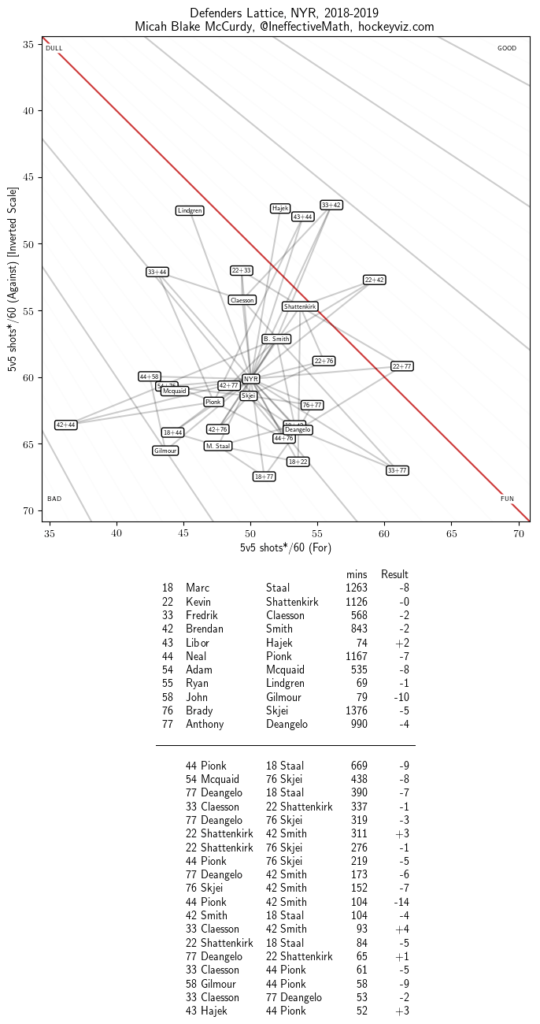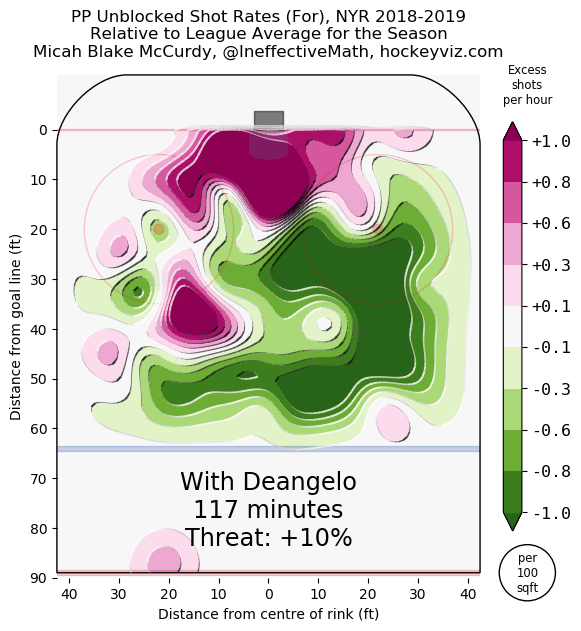
Tony DeAngelo came into this season presumably fighting for his Rangers career. The supremely talented defenseman had to conquer his attitude and off-ice issues to be a legitimate contributor on this club. David Quinn was the coach hired to do just that – coach and train his players not just to be better players, but to be better NHLers and professionals. For DeAngelo, growth off the ice was more important than growth on the ice.
Luckily for the Blueshirts, he did just that. After spending a good chunk of the first half of the season as a healthy scratch, DeAngelo finally stuck in the lineup and eventually skated in 61 games for the Blueshirts. He finished with a line of 4-26-30, tops among defensemen and sixth on the team. Not too shabby for someone who didn’t play the full season.
DeAngelo’s biggest issue on the ice was going to be his defensive zone play, with the mentality that his offensive play will certainly outweigh his defensive mistakes and he will be a net-positive on the ice. At a 48.07 xGF%, on the surface it looks to be a true statement. Breaking this down we get a team leading (by a mile) 3.04 xGF/60, which is just truly great. His 2.55 xGA/60 is actually better than I thought it would be, but still is 5th on the team. Only Marc Staal and Neal Pionk were worse defensively. But for DeAngelo, the offense is worth the defensive shortcomings.
Getting the most out of DeAngelo’s offense while limiting his defensive miscues is a must for Quinn going forward. Luckily, we can see how DeAngelo fared with his defense partners.
DeAngelo spent most of his time with Staal, much to DeAngelo’s detriment in terms of overall shot rates. He did significantly better when paired with Brady Skjei for 319 minutes, and towards the end of the season it looked like that pair was clicking well. It may not be the top pairing on defense that we hope for, but DeAngelo and Skjei complement each other nicely, and both are great skaters. Hopefully we get more than 300 minutes of ice time to see if they can do better than just tread water.
With DeAngelo, he’s going to be the next powerplay QB once Kevin Shattenkirk’s contract is up, or he is traded. So let’s focus on how DeAngelo runs the man advantage.
What I find to be interesting about DeAngelo’s presence on the powerplay is less about shots from where DeAngelo is on the ice, and more about the heavy concentration of shots from in front. This is only 117 minutes of powerplay time though, so it’s to be taken with a grain of salt. The big number to look at is the threat percentage, which is 10% above league average when DeAngelo is on the ice. It is worth noting, though, that DeAngelo received PP1 time with Mika Zibanejad and Chris Kreider.
Without DeAngelo is a significantly larger sample size of 253 minutes, and we see a whopping 25% swing in threat level to an anemic -15%. This is certainly a positive for DeAngelo, showing that he had a significant impact on the powerplay in such a small amount of time. This does, however, take credibility away from Shattenkirk, who was primarily on PP2 once DeAngelo stuck in the lineup.
With DeAngelo, the expectation was that his offense would cover up his defensive issues and be an overall net positive. That was certainly the case, and I think it’s safe to say the kid exceeded expectations, both on and off the ice. Perhaps Quinn got through to him. Perhaps the kid grew up. It’s likely both, but it bodes well for the Ranges.
Grade: A-
Share:
More About:Players



